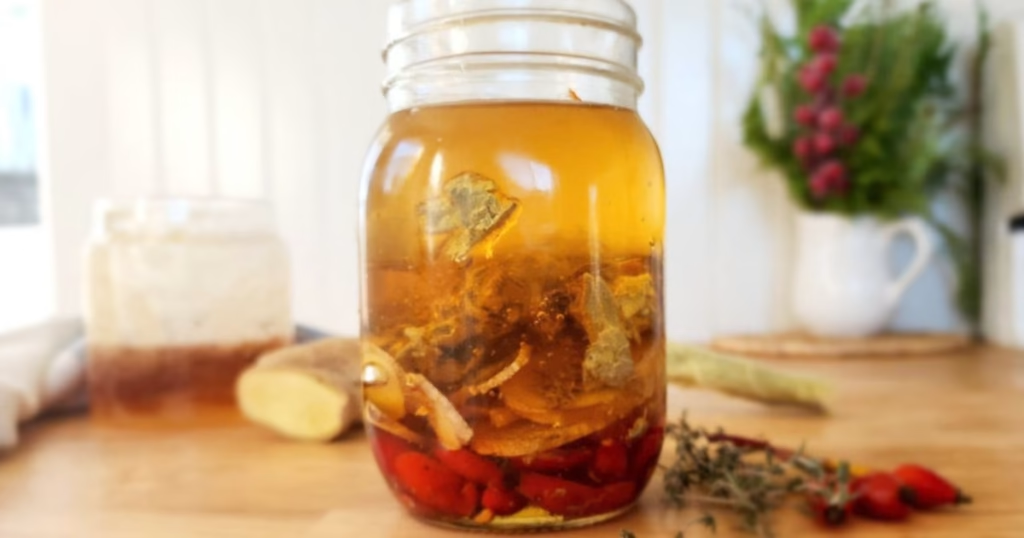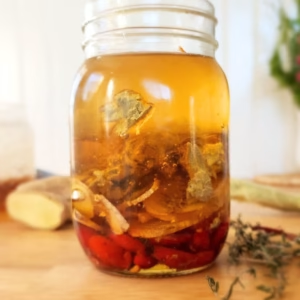With cold and flu season approaching, I’m excited to share this simple oxymel recipe made with honey, apple cider vinegar, and healing herbs like ginger, rosehips, thyme, and mullein. It’s a soothing natural remedy that helps ease cold symptoms, sore throats, congestion, and coughs, while supporting the immune system.

Disclosure: as an Amazon Associate, I earn a small commission from qualifying purchases at no extra cost to you. Read my full Disclosure and Policy here.
Welcome back to my natural remedies series! Summer has been busy with harvesting, drying, and preparing herbs, and I’ve been making all sorts of healing recipes like my plantain salve and yarrow salve.
As the weather turns cooler, now is the perfect time to prepare a few natural remedies to strengthen the immune system and soothe those inevitable seasonal sniffles.
For this oxymel, I used ingredients I already had on hand: freshly harvested rosehips (picked after the first frost), thyme from my garden, and mullein I dried over the summer. Combined with warming ginger, raw honey, and apple cider vinegar, this oxymel is a wonderful, time-tested tonic to boost immunity and ease sore throats, congestion, and coughs.
What is an Oxymel?
An oxymel is a traditional remedy made by combining honey and vinegar. Its name comes from the Greek words oxus (acid) and meli (honey). The result is a sweet-and-sour tonic that can be infused with herbs, fruits, or spices for added health benefits.
Both honey and vinegars have been valued for centuries for their antibacterial, anti-inflammatory, and antioxidant properties. When infused with medicinal herbs, the oxymel becomes a potent (and delicious) way to preserve plants and enjoy their healing benefits all year long.
Some studies even suggest oxymels may help support heart health, digestion, and weight balance — but most of all, they shine as gentle, effective immune tonics.
Simple oxymel made with honey and apple cider vinegar combine the two ingredients’ benefits such as anti-bacterial, anti-inflammatory, and anti-oxidant properties, as reported by some studies (source).
Some preliminary studies suggest that consumption of oxymel may help lowering the blood cholesterol level and contribute to weight loss (source).
When you add medicinal herbs to a simple oxymel, you also add those herbs’ benefits. In addition, making an oxymel, similarly to making tinctures or infused oils, is a great way to preserve plants and use them all year long.

Oxymel FAQs
How do you make an oxymel?
An oxymel is a simple yet powerful preparation made by combining honey and vinegar. Traditionally, oxymels were composed mostly of honey, but modern versions often use a more balanced ratio of honey to vinegar. Medicinal herbs are frequently infused into the mixture to enhance its therapeutic benefits. This can be done through a cold infusion, where the herbs steep in the honey and vinegar at room temperature for several weeks, or through a warm infusion, where the herbs are first steeped in gently heated vinegar before mixing it with honey. Both methods extract the herbs’ beneficial properties, resulting in a soothing, shelf-stable tonic that supports wellness throughout the year.

What is the shelf life of oxymel?
A simple oxymel or an oxymel made with dried herbs can be stored at room temperature in a sealed jar and in a dark place for up to 6 months. However, oxymel made with fresh ingredients, are better stored in the refrigerator. Refrigerating increased the shelf life to up to 1 year.
What is the best vinegar for oxymel?
You can use any good-quality vinegar, but raw apple cider vinegar is my favorite. It’s rich in beneficial enzymes and probiotics, supports digestion, and has a pleasant tangy flavor that pairs well with honey and herbs. Other great options include white wine vinegar, red wine vinegar, or herbal vinegars. Use raw and unpasteurized vinegars when possible for the best results.
How much oxymel can you take daily?
Typically, 1 to 2 tablespoons per day is plenty. You can take it straight, mix it into warm water or tea, or even drizzle it over salads. Because of its natural acidity and sugars, it’s best not to exceed 3–4 tablespoons daily.

Can children take oxymel?
Yes, children over 1 year can safely take oxymel in small doses. However, never give honey to infants under 1 year old due to the risk of botulism.
What are the best herbs for oxymel?
You can use any medicinal herb or combination of herbs to make oxymel, or you can even omit the herbs and simply combine honey and vinegar. You can adapt your oxymel depending on your needs. For example, for digestive comfort use peppermint, fennel, chamomile, or ginger. For a soothing and calming tonic use chamomile, lavender, lemon balm, or passionflower. For immune support include ginger, thyme, rosehips, elderberry, echinacea, mullein, and/or citrus peels.
What Are the Benefits of This Oxymel with Ginger, Rosehips, Thyme, and Mullein?
This oxymel is one of my favorite go-to natural remedies for colds and flu.
- Raw honey is naturally antibacterial and anti-inflammatory, honey soothes sore throats and calms coughs.
- Ginger is a warming, stimulating herb that boosts circulation, eases nausea, reduces inflammation, and supports the immune system.
- Rosehips are rich in vitamin C and antioxidants, they help strengthen immunity, shorten cold duration, and support recovery.
- Thyme is a powerful respiratory herb with antibacterial, antiviral, and expectorant properties. It helps loosen mucus and clear congestion.
- Mullein soothes dry coughs, coats irritated throats, and supports healthy lung function.
Together, these herbs make a delicious, immune-boosting oxymel that helps soothe sore throats, clear congestion, and ease coughs, all while supporting the body’s natural healing processes.
Enjoy 1–2 tablespoons daily, or mix it with warm water or tea for an instant comforting drink.
Ingredients For This Oxymel for Colds and Flu

Honey. Use raw honey, preferably from local sources. Manuka honey is also a great option with even more health benefits.
Apple cider vinegar. Raw, unfiltered apple cider vinegar is the best option for its unique health benefits. You can also use other vinegars.
Ginger. Use fresh ginger root, sliced or grated. If you don’t have fresh, dry ginger is also an option. Use about 1 tablespoon of dry ginger powder.
Rose hips. This is a great recipe to use rose hips you may pick in the fall. Use fresh or dry rose hips, removing the stems and cutting or blending the berries to increase their beneficial properties. You can of course also purchase some organic dry rose hips like these ones. You can also use elderberries for a powerful immune boosting oxymel.
Thyme. Use dry thyme, about one tablespoon.
Mullein. Use dry mullein leaves. Crash them if needed. I harvest my mullein in the summer when the plant is in full bloom and air-dry the leaves for teas, tinctures, and oxymels. You can also purchase some organic dried mullein leaves like these ones.
Tools You May Need
Pint mason jar with plastic lid or regular lid lined with parchment paper.
Fine mesh strainer or cheesecloth.
How To Make This Oxymel
Step 1: Gather and prepare all ingredients. Cut the rosehips in half, or pulse them in the food processor. Slice or grate ginger root. Crush thyme and mullein, if necessary.
Step 2: Add rose hips, ginger, thyme, and mullein to a pint mason jar.

Step 3: Add one cup of honey over the herbs.

Step 4: Fill the jar with apple cider vinegar.
Step 5: Close the jar with a plastic lid or with a regular metal lid lined with a piece of parchment paper or cloth to avoid the acid vinegar touching the metal. Shake vigorously until all ingredients are incorporated.

Step 6: Place the jar in a dark place for 2-3 weeks. Shake very couple of days.

Step 7: Strain the oxymel through a fine mesh sieve or cheesecloth, squeezing out all the liquid from the herbs. Collect the liquid in a labeled jar. Store in the refrigerator and use within 1 year.

Notes
Feel free to adjust the herbs based on what you have or your specific needs. Scroll up for ideas.
Store in the refrigerator and discard if you notice any mold or off smells.
Take 1–2 tablespoons daily as needed, diluted in water or tea.
Do not give honey to infants under 1 year of age.
Pin it For Later

More Posts You May Like
Tonic and Soothing Drink with Ginger, Honey, and Apple Cider Vinegar
Plantain Salve: Easy Recipe for Cuts, Bug Bites and More
Yarrow Salve: Easy DIY Recipe for Soothing and Healing Skin
Tallow Face Cream: Easy Recipe, Amazing Moisturizer
DIY Lemon and Vinegar Cleaner: Easy, Effective, All-Natural
Health Benefits of Spending Time Outdoors
10 (Fun) Ways to Exercise More Without Working Out
Morning Sunlight Benefits: Circadian Rhythms, Mood, and More
Printable Recipe Card

Easy Oxymel Recipe for Colds and Flu
Equipment
- Pint mason jar with plastic lid or regular lid lined with parchment paper.
- Fine mesh strainer or cheesecloth.
Ingredients
- 1 cup honey raw
- 1 cup apple cider vinegar raw, or enough to fill jar
- ¼ cup rosehips fresh or dry
- 2 inch fresh ginger root sliced
- 1 tbsp thyme dry
- 1 tbsp mullein leaves dry
Instructions
- Gather and prepare all ingredients. Cut the rosehips in half, or pulse them in the food processor. Slice or grate ginger root. Crush thyme and mullein, if necessary.
- Add rosehips, ginger, thyme, and mullein to a pint mason jar.
- Add one cup of honey over the herbs.
- Fill the jar with apple cider vinegar.
- Close the jar with a plastic lid or with a regular metal lid lined with a piece of parchment paper or cloth to avoid the acid vinegar touching the metal. Shake vigorously until all ingredients are incorporated.
- Place the jar in a dark place for 2-3 weeks. Shake very couple of days.
- Strain the oxymel through a fine mesh sieve or cheesecloth, squeezing out all the liquid from the herbs. Collect the liquid in a labeled jar. Store in the refrigerator and use within 1 year.







Hey there! I really appreciate you explaining this so clearly. I am a new mama and a beginner with natural home remedies, and this made it so simple. I am going to put this on my list of things I want to make for the winter months! Do you recommend starting with making this or fire cider!
Hi Meredith, so glad you’re here and that you’re making an effort to switch to natural remedies, so exciting! To answer your question, fire cider and oxymel are very similar things. Usually, in a fire cider you use more “pungent” and stronger herbs like garlic, onion, hot pepper, horseradish, all great as an immune booster. So while this oxymel is pretty mild (but effective) and is really great sipped in warm water when you’re feeling a cold coming, fire cider is usually taken as a “shot”. Hope this helps!
I subject my family to fire cider, cod liver oil, and elderberry syrup in the wintertime..perhaps this will be a better tasting version of fire cider for my kiddos! Can’t wait to try!
Thank you so much, Meghan, I hope you’ll enjoy this recipe, I find it really yummy in some warm water 🙂 And fun fact, my kids love cod liver oil, they literally fight over the bottle whenever I take it out from the fridge lol. Do you kids also like it??
Perfect way to use the ACV I just made!
That’s wonderful! Thank you, Ash.
I’m so excited! I have all the ingredients for this recipe! I used to make oxamel and took a spoonful every morning, but I got out of the habit. Thank you for inspiring me again!
Aw that’s awesome, thank you, Margareta!
This is a great recipe! I just made a couple of oxymels a few days ago, but I might have to make another one now, I love the ingredients in yours and I do have all of them, Yay!
Thank you so much, Heidi, we’ve been loving this soothing oxymel, it really helps with those pesky colds!
Thank you, Marta! I’ve never heard of this, but I’m so intrigued. I love DIY’ing natural products to use at home to help boost the immune system especially during cold and flu season. I’m gonna have to try this!
Thank you so much, Kelly, glad you liked this recipe!